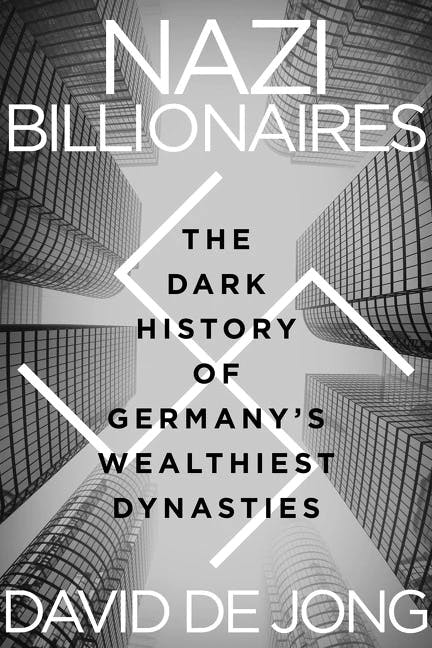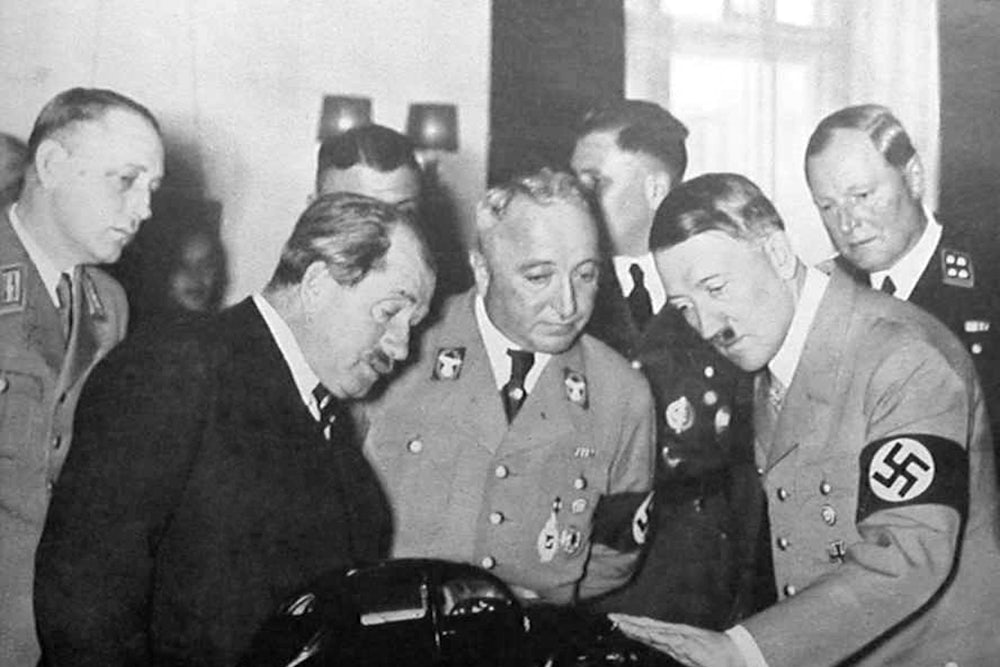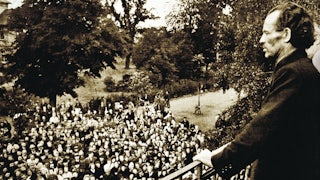David de Jong opens his book, Nazi Billionaires: The Dark History of Germany’s Wealthiest Dynasties, with a vignette about an unrepentant heiress. In 2019, Verena Bahlsen, the 26-year-old inheritor of Germany’s most famous cookie company, gave a speech at a conference in Hamburg. Responding to a socialist politician’s suggestion that ownership of Germany’s largest companies should be distributed, she declared her unequivocal support for capitalism and her pride in her immense wealth: “I am a capitalist,” she ad-libbed. “I own a quarter of Bahlsen and I am happy about it. It should continue to belong to me. I want to make money and buy sailing yachts from my dividend.” Days later, a journalist asked her to justify her bragging about her wealth, given that her family’s company used forced labor during World War II, paying foreign workers meager wages in appalling conditions. Again, she was impenitent: “That was before my time and we paid the forced laborers exactly the same as the Germans and treated them well.”
Condemnation was swift, with global headlines announcing outrage and ire. Following Bahlsen’s comments, de Jong writes, journalists at Der Spiegel investigated her family past. They confirmed that her grandfather and great-uncles, who ran the Bahlsen company during the Third Reich, had been Nazis and donated money to the SS, the Nazi paramilitary organization; they had also expropriated a cookie factory near Kyiv, from which they had imported the workers and then paid them slave wages. “After the war, like millions of Germans, the Bahlsen men denied all charges of complicity with the Nazis and got off scot-free,” de Jong writes. To stanch the current outrage, the Bahlsen family hired a prominent German historian to write an independent report on the family’s Nazi-era actions. “The announcement worked,” de Jong reports, “and the controversy faded.”

Attitudes like Bahlsen’s were meant to be a thing of the past. I recall, as a child growing up among secular American Jews in the 1990s, plenty of talk among the generations above me about boycotting German brands. The reviled companies weren’t only the obvious ones, like Volkswagen or Siemens, directly associated with Nazi rule; many also avoided smaller but historical consumer brands like Birkenstock or Nivea or Miele. The assumption was that those companies, if they persisted through the years of the Nazi regime, must have found a way to work within the fascist system that deprived so many of their rights and lives.
Later, as a college student and after, I spent some years living in Berlin; this was at the height of the celebration of Germany as a bastion of Vergangenheitsbewältigung, or working through its past. It was before the entrance of Alternativ für Deutschland into mainstream politics, the era when Germany hosted the World Cup and finally began, without shame at any hint of nationalism, to fly its flag; when, as Tony Judt wrote in 2005 in Postwar, “Holocaust recognition is our contemporary European entry ticket,” and every European capital had to have a memorial to war crimes to be part of the liberal European project. In this, Berlin, studded with publicly funded memorials, was the epitome. I went home to the United States and told my parents and their friends that they needn’t worry about supporting German brands or the country’s economy; the country would always be engaged in holding itself to account for its brutal totalitarian past.
De Jong’s book is a strong rejoinder to that narrative. In a densely researched account of five wealthy German families, each of which not only benefited from but strengthened the Nazi regime, de Jong suggests that neither German society nor the German state has fulfilled its promise to denazify German business and industry, even in the many decades since the end of the war. He offers Bahlsen’s story as just one instance in a pattern of convenient forgetting in contemporary Germany. The promise of Vergangenheitsbewältigung, according to de Jong, has not been fulfilled—at least when it comes to Germany’s wealthiest families.
Each of the five dynasties de Jong covers still numbers among Germany’s wealthiest clans. First, there are the Quandts, who got their start as textile magnates, expanded into steel and munitions, and whose heirs now control BMW, Mini, and Rolls-Royce. Second are the Flicks, a family of industrialists who, despite being the only family represented here who were tried at Nuremberg and sentenced for war crimes, have never paid reparations. Next come the von Fincks, private bankers and insurance scions who helped found Hitler’s Museum of German Art and whose heir now funds German far-right political organizations. There are the Oetkers, who control Dr. Oetker, a consumer foods company valued at $8 billion that is known around the world for its pudding powders and frozen pizzas, as well as a sparkling wine company and a portfolio of luxury hotels. Finally, we have the Porsche-Piëchs, not only the founders of Porsche (and now controlling owners of the Volkswagen group, which includes Audi, Bentley, and Lamborghini) but close associates of Hitler who pitched him the idea of the Volkswagen—a “people’s car”—and used slave labor to build a factory to produce it.
In prose that is readable but not especially artful, de Jong, a reporter for Bloomberg, likely provides more detail on the structures of business deals and family succession than most lay readers would need—at times, his exhaustive detail makes this feel more like an academic text—but in doing so makes a valuable contribution to committing to the record the full account of these families’ crimes. De Jong details how each of these families slowly escalated its support for and intertwinement with the Nazis. Each donated to the Nazis, beginning early in the 1930s, in an effort to quash democratic society and help Hitler’s party consolidate total control; leveraged close connections to the regime to generate business; contributed to the war effort, whether by financing industry, designing tanks, or producing metals and munitions; expropriated businesses from Jews under Aryanization laws; and used forced labor from concentration camps. In short, these were not the average German citizens who might claim that they didn’t know what was going on. These were the men rubbing shoulders with Nazis leading the charge, and who benefited mightily from knowing them.
As with any book that tracks the arc of the Nazi regime, this one gets grimmer and more grotesque as it progresses, moving from accounts of backroom business deals to vivid descriptions of the mistreatment of forced laborers. At the height of the war, any German business could go to the local labor office and request coerced workers; these were largely Ostarbeiter, or workers sent to concentration camps in the occupied East who were then transported to Germany and elsewhere. Alongside more widely known villains like I.G. Farben, Krupp, and Daimler-Benz, the moguls in this book were among the first to do so. By 1943, half of the workers for the Flick family conglomerate—approximately 130,000 people—were forced or slave laborers.
The details of what happened in the sub-concentration camps built expressly to house these families’ forced laborers are chilling and stomach-turning. At one of the lead factories owned by the Quandts, forced laborers were denied protective equipment and so suffered lead poisoning and third-degree burns that required amputations. The Porsche-Piëchs’ forced labor camp was the site of mass rapes of the women working there; once they gave birth, their infants were taken from them by force to an orphanage where at least 365 children died from neglect and infection. At the end of the war, the forced laborers left at the Quandts’ labor camp in Hannover were evacuated to shield their existence from the Allies. But the train they were on was blocked by another bombed-out train on the tracks; with American troops closing in, the SS and Wehrmacht decided to lock the remaining captives in a barn and set it on fire. SS forces threw hand grenades onto the burning structure and gunned down people who tried to flee. American soldiers later discovered the charred bodies of 1,016 people, all of whom had been moved out of the Quandt family business’s dedicated forced labor camp; many had been burned alive.
Some of this may not be entirely new information to Germans, who may have read about or watched documentaries about some of these families in their national press; but a stated and essential part of de Jong’s project is to make this information available to English-language readers. De Jong quotes Rüdiger Jungbluth, a German journalist whose books on the Quandts and Oetkers revealed those families’ crimes, at least in the German-speaking world, without much change in their treatment: “When it’s not written in English, it’s not considered news.” When a company has global reach, presenting information in English, de Jong hopes, might have a more significant impact.
De Jong feels motivated to revisit these crimes in part because the families continue to obscure them. Almost all of the living members of these families declined to speak to de Jong, and their corporate representatives, if they responded at all, pointed de Jong to the kinds of family-commissioned histories that the Bahlsen family announced—reports written in dense academic German, available only in hidden corners of corporate or foundation webpages. The mere existence of these reports does little, de Jong argues, if they are not widely accessible, or if they do not simultaneously cause the families to take greater responsibility for their crimes. Further, de Jong rails against these families’ use of philanthropy to whitewash history. The Quandts, for example, can still garner prestige from the Herbert Quandt Media Prize, named after a Nazi who committed war crimes; the Ferry Porsche Foundation, dedicated to “reinforcing its commitment to social responsibility,” can endow a professorship in corporate history at a distinguished German university as “an invitation to family companies in particular to engage with their history more intensively and candidly.” De Jong feels unheimlich when he spots Quandt and Flick on a wall of donor names at the Tel Aviv Museum of Art.
In an interview with Anand Giridharadas about the book, de Jong argues that “at the bare minimum, the public should expect historical transparency when it comes to [these families’] business successes, their war crimes, their Nazi affiliations. If they don’t want to do that, they should rename their foundations, corporate headquarters, and media prizes. That is minimal justice.” The only response he gets on this front is from Jörg Appelhans, a spokesman for the Quandt siblings who now control BMW: “The Quandt family is convinced that the goals of openness and transparency have been achieved. We don’t believe that renaming streets, places, or institutions is a responsible way to deal with historic figures because such ‘damnatio memoriae’ … prevents a conscious exposure to their role in history and instead fosters its neglect.”
Having made a clear case for just how repugnant each of the families’ patriarchs was, de Jong then goes on to describe how almost all of them were allowed to go free after the Third Reich fell, their fortunes intact. But whereas he went into great detail about how these families accumulated their wealth, his explanations about the justice process in the postwar period are more muddled. Unfortunately, he doesn’t manage to successfully give a bigger-picture sense of why denazification failed.
As he better explains in an interview elsewhere, geopolitical priorities shifted so quickly in the postwar period that the appetite for a long judicial accounting of Nazi crimes was short-lived. Although the Allies declared at Potsdam their intention to dissolve Nazi organizations and institutions, repeal Nazi laws, and remove anyone who was more than a nominal member of the Nazi party from positions of power and influence, that process largely failed because the U.S. quickly became more invested in West Germany’s role as a capitalist, democratic bulwark against Soviet Russia. Soon came the Marshall Plan and a new policy stance that emphasized German self-governance over punishment; forgotten or ignored were the crimes that animated the Third Reich. Those who were able to stall the justice process long enough were often let go with lenient sanctions, if they suffered any at all.
Indeed, the Allies initially planned to hold a mass trial at Nuremberg of industrialists, businessmen, and financiers for war crimes, as they had for political figures; some of the families featured in de Jong’s book were considered for inclusion. But by 1947, interest in pursuing such international trials had subsided; that year, the Truman administration decided not to continue to prosecute Germans as the occupying power and instead handed over hundreds of thousands of suspected Nazi perpetrators and sympathizers to local tribunals in what became known as “denazification trials.” Because of the scale of the undertaking, most of the judges and prosecutors were laymen. The German dictatorship had fallen not due to internal revolution but as a result of external, military defeat; when the accused were turned back over to German authorities, the process fell apart. Germans were loath to pass judgment on their compatriots for acts that they either privately condoned or participated in themselves. Of more than 12 million people who were required to register as part of the denazification process, more than nine million, or three-quarters, were found not chargeable. Millions were granted amnesty without trial; of those who were tried, about a third were exonerated. Ultimately, denazification petered out, reopening control of German public, economic, and cultural life to individuals who had only been temporarily prevented from exercising it.
The families that de Jong profiles all benefited from these failures. In the end, only three industrialists, one of whom was Friedrich Flick, were tried at Nuremberg. Flick was an exception to the general rule, in that he was found guilty of war crimes and sentenced to seven years in prison. But, as de Jong argues, his punishment was inadequate: He served only five years, after the American high commissioner of occupied Germany, who oversaw a series of controversial acts of clemency, reduced his sentence for good behavior, and he was soon able to return to running his businesses. The other moguls that de Jong profiles collected statements from family, friends, and colleagues to submit to the courts to help exonerate them by refuting their alleged crimes or speaking to their good character. These affidavits came to be known as Persilschein, or “Persil tickets,” named after a famous brand of German laundry detergent, a term used for any statement that sought to wash clean any stain of association with the Nazis. Often, a Persilschein was enough to grant a German defendant accused of Nazism a certificate of good standing, which allowed the person to return to a job or to regain control over a business. Quandt, Porsche, von Finck, and Oetker all used this method with great success.
It’s worth noting that de Jong’s portrayal of the failures of denazification tends to emphasize its worst failures. De Jong selected the families he follows precisely because of the wealth they still hold today, not because they were the most influential business people in the regime. Because the starting point is the continuity of their wealth, that means they cannot really have been held to account. The executives of other companies, such as I.G. Farben, who were tried at Nuremberg, were more seriously sanctioned, and that company was broken up.
De Jong’s exploration of the postwar period left me wondering if his focus on the culpability of the families was sufficient. It’s the descendants, he argues repeatedly, who should acknowledge their wrongdoing. But what about the state? Shouldn’t Germany, both the government and the society, bear some responsibility for this? What might a more comprehensive justice process have looked like? And what options might be available now to rectify these past wrongs?
Nevertheless, de Jong’s thesis holds. By detailing the stories of these five families, he makes a strong case that the German tendency toward self-reflection or addressing past wrongs has only been true up to a point; it has failed when it comes to the country’s wealthiest families. The idea that the country’s institutions have confronted Nazi crimes is an incomplete assessment; perhaps Germany is not, as we’ve thought, a shining model of reckoning with its past. What other explanation is there if the country remains beholden to rich, powerful families and their global companies?






